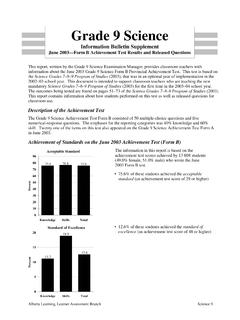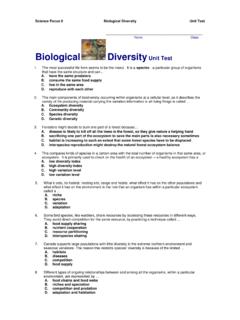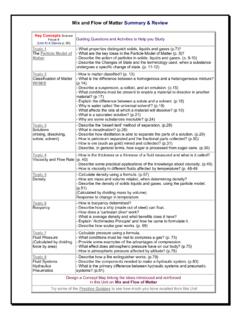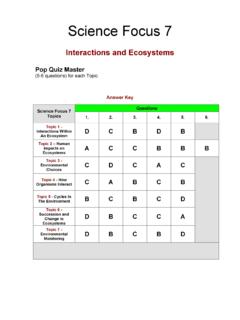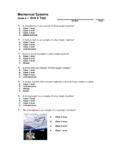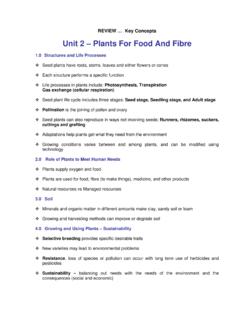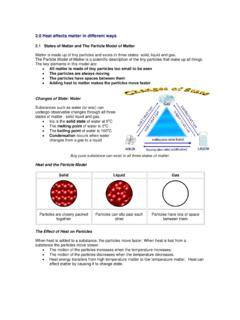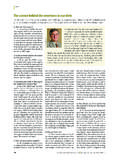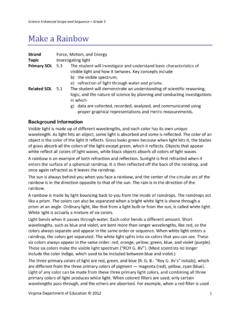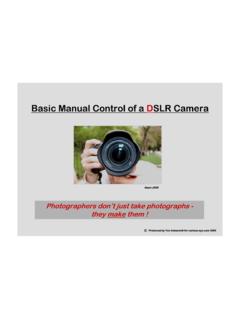Transcription of Science Focus 8 - EDQUEST SCIENCE
1 Teaching Notes for light and Optical Systems Grade 8 SCIENCE Focus 8 Teaching Notes EDQUEST Resources 2001 EDQUEST Middle School Resources 2002 Teaching Notes for light and Optical Systems Grade 8 Topic 1 What is light ? (pages 176 187) Simply stated, light is the form of energy you can see. This energy can be produced naturally by the sun or fire, or artificially by light -producing technologies, like batteries. Radiation is the wave like transfer of light from its source in all directions. light is often called radiant energy. light from the sun is formed by nuclear fusion (Off the Wall p. 176) The First Basic Principle of light light is a form of energy When light reaches a surface, it can be absorbed and transformed into other types of energy.. into electrical energy .. into thermal energy .. into chemical energy Solar cells change light into electricity Cameras change light into thermal images Trees convert light energy into food (chemical energy) The amount of energy a surface receives depends on the intensity of the light .
2 The more intense the light , the more light can be absorbed. Sources of light Natural light Sources Artificial light Sources Sun Incandescent (heat causing a filament of metal to glow visible light ) Electrical energy Thermal energy Visible light energy Candles or Oil Lamps Florescent (ultraviolet light is absorbed by fabric particles, which in turn emit some of the energy as light glowing) Ultraviolet light Energy absorbed Visible light energy by particles energy Wood (fire) Phosphorescent ( light energy is stored and released later as visible light ) paint Bioluminescence ( light produced by living organisms) firefly light Chemiluminescent ( light energy released by chemical reactions) glow sticks Chemical energy Visible light energy Other sources of light Energy can come from the Earth s minerals including.
3 THERMOLUMINESCENCE and TRIBOLUMINESCENCE EDQUEST Middle School Resources 2002 Teaching Notes for light and Optical Systems Grade 8 The Cost of Lighting Electrical energy costs money to produce. A watt is a unit of electrical power. The cost is calculated by how much of the electrical energy is used over a certain period of time. Calculations are made in s. 1 is 1000 watts of electrical energy operating for 1 hour. Example: Calculate the cost of leaving a 60W light bulb on for 10 hours. Convert 60W to kW by dividing by 1000 60 W / 1000 = kW Calculate the number of kW hours kW x 10 hours = Calculate the cost by multiplying the number of hours by the cost per If the cost per is $ The cost of electricity to operate the 60W light bulb for 2 hours would be x $ = $ ( cents or about 5 cents) The Ray Model of light light travels in straight lines Because of this principle, the ray model of light can help to explain certain properties light .
4 A ray is a straight line that represents the path of a beam of light . The ray model helps to explain how shadows can be formed, when the ray of light is blocked by an object. A ray diagram Bright Bright LightSource Shadow light travels in straight lines until it strikes a surface. The type of surface will determine how the light will continue. If the surface is transparent, the light continues in a straight path through the object If the surface is translucent, the light will be diverted (refracted) after it passes through If the surface is opaque, the light will be blocked and not allowed through the object Diagram (Figure ) EDQUEST Middle School Resources 2002 Teaching Notes for light and Optical Systems Grade 8 Topic 2 Reflection ( pgs. 188 199 ) ( Optics Website ) Reflection is the process in which light strikes a surface and bounces back off that surface.
5 How it bounces off the surface depends on the Law of Reflection and the type of surface it hits. If it hits a rough surface, the light is scattered. If it hits a smooth surface, the light reflects at an opposite angle to the angle it hits. light coming from a light source is called an incident ray and the light that bounces off the surface is called a reflected ray. A line that is perpendicular ( 90o with the surface) to the plane mirror is called the normal line. The angle between the incident ray and the normal line is called the angle of incidence ( i ). The angle between the reflected ray and the normal line is called the angle of reflection ( r ). Forming An Image The Law of reflection states that: the angle of incidence equals the angle of reflection the incident ray, the normal line and the reflected ray lie in the same plane (an imaginary flat surface) Figure p. 194 An image is formed in a mirror because light reflects off all points on the object being observed in all directions.
6 The rays that reach your eye appear to be coming from a point behind the mirror. Because your brain knows that light travels in a straight line, it interprets the pattern of light that reaches your eye as an image of an object you are looking at. Figure explains why an image in a mirror is the same size as the object and appears to be the same distance from the mirror as the object. (only true for flat mirrors) EDQUEST Middle School Resources 2002 Teaching Notes for light and Optical Systems Grade 8 Curved Mirrors Mirrors that bulge out are called Convex mirrors Mirrors that cave in are called Concave mirrors Convex mirrors form images that appear much smaller and farther away than the the object - but they can reflect light from a large area, making them useful as security devices. Concave mirrors form an image that appears to be closer than it actually is and can be useful because it can also reflect light from a large area - side mirrors on automobiles.
7 Rough Surfaces Smooth surfaces reflect light uniformly Rough surfaces appear to reflect light randomly, but this seemingly scattered light creates the image of the print on the page. light hits the white paper and reflects in all directions (some of it reaching your eye). Since there is no pattern, your eye just sees white light . The ink on the paper absorbs the light and no light from the ink reaches your eye. Therefore your eye sees the letters in black ink. (see Figure , p. 198) Using Reflections Reflectors help to make bicycles and cars visible at night. A reflector is made up of hundreds of tiny, flat reflecting surfaces arranged at 90o angles to one another. These small surfaces are packed side by side to make the reflector. When light strikes the reflector the light bounces off the tiny surfaces and bounces back toward the light source. Pool players use the law of reflection to improve their game.
8 Like a light ray, a pool ball travels in a straight line. In a 'bank shot' (Figure , p. 199) the cue ball is bounced off the cushion at an angle which enables the player to hit the target ball. This angle is calculated as the angle of contact (with the cushion) is equal to the angle of impact (with the target). Topic 2 Review p. 199 EDQUEST Middle School Resources 2002 Teaching Notes for light and Optical Systems Grade 8 Topic 3 Refraction ( pgs. 200 205 ) Refraction is the process in which light is bent, when it travels from one medium to another. light bends because it changes speed when it moves through materials that have different densities. light travels slower in materials that are more dense, because there are more particles. The bending of light makes the object's image appear to be in a different position than it really is.
9 Around a Bend with light The Law of Refraction states that: when light travels from one medium, to a more dense medium, the light will be bent toward the normal, and when it exits the denser medium into a less dense medium, it will bend away from the normal. The new direction of light is called the angle of refraction. Image Refraction can also occur when light travels through air at different temperatures, because warm air is less dense than cold air. The refraction of light through air is called a mirage. The pools of water you see on a hot summer day are often caused by this effect, because the air closer to the ground is hotter than the air above it. As you approach these pools, they disappear - because they were never there. Is That All There Is To light ? What happens when light strikes a surface? .. Type of behavior What happens to light striking a surface Nature of surface What else happens?
10 Absorption Energy Transformation rough, dark, opaque some light is reflected Reflection Bounces off smooth, shiny some light is absorbed Refraction Travels through in a new direction different transparent medium some light is reflected Topic 3 Review p. 206 Wrap-Up (Topics 1-3) p. 207 EDQUEST Middle School Resources 2002 Teaching Notes for light and Optical Systems Grade 8 Topic 4 Lenses and Vision ( pgs. 208 220 ) A lens is a curved piece of transparent material (glass/plastic). When light rays pass through it, the light is refracted, causing the rays to bend. A double concave lens is thinner and flatter in the middle than the edges. light passing through the thicker more curved areas of the lens will bend more than light passing through the thinner areas, causing the light to spread out or diverge.
